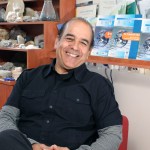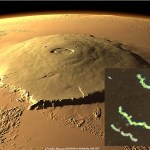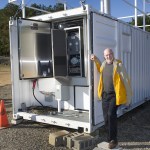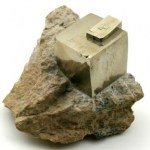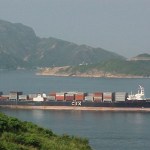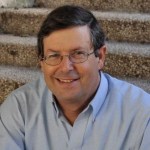environmental science
Prof. Nir Orion
Science Teaching researcher Prof. Nir Orion recently returned from Peru, where his award-winning Blue Planet teaching unit was adopted by the Peruvian Ministry of Education
Q: You have been working for many years to get schoolchildren out of the classroom setting. Why?
A: Schools in general and science teaching in particular are supposed to teach children about the world they live in. But they do it in a sterile environment that is disengaged from the real world; and thus many students do not find relevance or personal meaning in the subjects they “learn.”
There are,…
Speaking of sulfur: This common element turns out to be highly useful for understanding planetary processes – both on Earth and Mars. Two new papers by Dr. Itay Halevy use sulfur chemistry to understand the history of sulfur-loving microbes at the bottom of the ocean and the compounds spewed from Martian volcanoes that may have created brief Martian “springs.”
Sources of sulfur: Olympus Mons on Mars and sulfate-reducing bacteria that live in water on Earth (inset)
On the ocean beds, microorganisms “breathe” sulfur: They take in sulfate – an abundant compound of oxidized sulfur, and use it…
Inspired by the internet comic “The Up-Goer Five”, which used only the 1,000 most commonly used words to describe the Saturn V Rocket, scientists across the internet are attempting to describe their work using the just this small set of words. And it’s tough! But one of Brookhaven’s atmospheric scientists was up to the challenge. Alistair Rogers, who works in our Environmental Sciences Department, gives it a go:
Understanding change at the top of the world so we’ll know what is going to happen later
When we drive cars and warm our homes we give out bad stuff that ends up in the air. The bad…
Here's the latest field report from the MAGIC climate research collaboration:
Greetings from Honolulu! I had a wonderful trip over – mostly calm seas (we had a bit of rock and roll the last day out, but it wasn’t too bad), nice weather, some nice clouds to observe, and MAGIC data! In port in LA was busy, as usual, with MAGIC personnel getting off and on the ship, and others coming in for installation. Most of the instruments are up and running well, and of course there are a few that are being a bit problematic, but that’s not unusual for this point in a deployment.
Weather balloon launches…
You’ve heard of the carbon cycle, maybe even the nitrogen cycle. But have you given much thought lately to the sulfur cycle? New research in last week’s Science suggests that we should be paying a bit more attention to the way this element moves through the atmosphere, biosphere, oceans and land. Over the last 500 million years, sulfur seems to have played a fairly crucial role in keeping the oxygen levels in the atmosphere at a nice, breathable 20%.
It is microbes and weather that do the work. Microorganisms in the ocean take in sulfur in the form of dissolved sulfate – that is, in a sulfur…
Brookhaven Lab atmospheric scientist Ernie Lewis with a mini "weather" balloon aboard the Horizon
This guest post was written by Ernie Lewis, an atmospheric scientist at Brookhaven Lab, who is leading a year-long climate study aboard two Horizon Lines cargo ships, the Spirit and Reliance. He recently returned from a preliminary "cruise" from L.A. to Hawaii and back aimed at assessing conditions for deploying instruments aboard the ships during the actual study, dubbed MAGIC, which will run from October 2012 through September 2013.
Hawaii was wonderful, even though I only had a…
The Horizon Spirit, a 272-meter cargo ship, makes the round trip between Los Angeles and Hawaii every two weeks.
This is not a story about the latest mega cruise ship, with five swimming pools, 10 restaurants, a rock-climbing wall, and a casino. The vessel we're talking about, the Horizon Spirit, will be outfitted instead with radars, aerosol sampling devices, and other high-tech tools. But even without the fancy umbrella drinks, Ernie Lewis, an atmospheric scientist at the U.S. Department of Energy's (DOE) Brookhaven National Laboratory, can't wait to set sail.
Last month, he and several…
This guest post was written by Brookhaven Lab science writing intern Kenrick Vezina, who will be sharing Brookhaven science stories from inside and outside laboratories on site through mid December.
I'm about to enter the well-worn, vegetation-free (read: tick-free) pathway that cuts through the forest near my dorm. I'm about two steps down the trail when I hear a screech from somewhere in the canopy overhead. It's not the full-out war cry of a red-tailed hawk -- the sound we've been trained by television to expect from the beak of every bird of prey -- but it definitely sounds like a raptor…
Today's science news from the Weizmann Institute covers research in neurobiology, environmental science and cancer immunology.
⢠In the first, scientists identified a likely biological marker for autism that shows up even in very young children. Diagnoses of autism are generally not possible so early, as the signs typically appear gradually throughout the first 3-4 years of life. The scientists used fMRI to scan the brains of children aged 1-3 who were just starting to show signs of autistic behavior. Their method: scanning the brains of toddlers while they sleep. It seems that even asleep…
These guys are as adept with a lug wrench as they are with a mass spectrometer. Prof. Dan Yakir (second from right) and members of his group had to become licensed truck drivers to operate their newest equipment - which is all packed into a custom-built truck for hauling around the country. Until now, Yakir and his team have been working from the Yatir station - a fixed tower set in a pine forest on the edge of the Negev desert. This station is part of a global network that continuously measures carbon exchange and other nutrient cycles in different forest settings. Now, he and his team will…
Three news items were posted on our site today. The first is on two papers by a group in Spain. Normally we don't publicize papers that are not written by Institute scientists, but these are a special case. They appear to have clinched the claims of a Weizmann scientist that one can treat stroke and head trauma without trying to get drugs into the brain. The treatment would consist of upping the levels of a naturally-occurring enzyme in the blood; one of these papers showed that levels of this enzyme in the blood tests of stroke patients were the best predictor of their chances of recovery.…
Today's guest blogger is Prof. Dan Yakir. Until recently, Yakir was head of the Environmental Sciences and Energy Research Department at the Institute, and he heads the Yatir Forest research station, which monitors, among other things, carbon exchange in a man-made semi-arid pine forest.
This piece comes in the wake of the worst fire in Israel's history, in which extreme drought, winds and a long fire season that depleted fire retardant supplies combined to flame a few embers into a major conflagration that burned thousands of acres of natural scrub forest.Tens of human lives were lost, many…
Next Saturday afternoon, at ScienceOnline2010, the science goddess, the chemspider, and I will be presenting a workshop on getting students involved in citizen science.
In preparation, I'm compiling a set of links to projects that involve students in citizen science. If you know of any good citizen science efforts, please share them in the comments.
Here we go!
Before I start listing links, I am limiting this list to projects that allow both students and citizen scientists to participate. I know of plenty of student projects, where students can isolate phage and annotate their genomes or…
